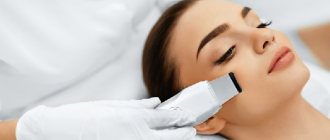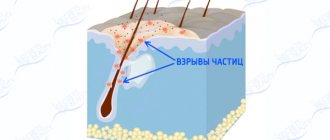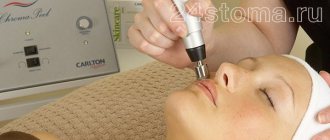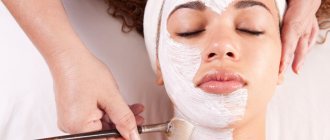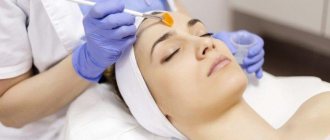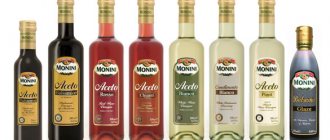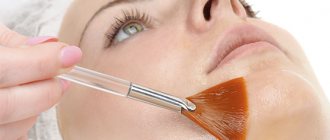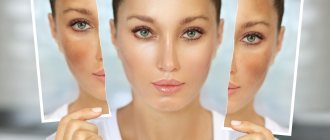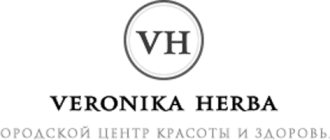The mechanical peeling option is considered the safest and easiest to perform. Methods for superficial exfoliation of the stratum corneum of the epidermis using various abrasive particles are more controlled, do not cause significant pain, and give no less effective results. One of the typical representatives of the group is coral peeling. This option is suitable for people prone to allergies and those with sensitive skin, which increases the demand for the substance. But you won’t be able to prepare the composition yourself; you will have to buy a ready-made preparation. Rose de Mer from the Israeli brand Christina is popular.
The principle of action of the drug
Rose de Mer is a bright representative of coral peeling; it has a coordinated composition that provides a comprehensive effect. The substance has an effective exfoliating effect. The components included in the composition help soften the surface layer, which facilitates the process of cleaning the surface.
Treated leather, which has experienced the mechanical work of solid particles, is exposed to components useful for restoration. Tissues receive nutrition and protection. The covers are leveled, tightened, strengthened. Mechanical damage to the top layer helps initiate regeneration.
Indications for use
The use of coral demabrasion Rose de Mer is indicated for deep cleansing, renewal, healing, and tissue rejuvenation. This option is best suited for those over 35 years of age. It is from this age that the complex effect of the drug is ideally expressed.
The tool copes with the following tasks:
- acne without purulent inflammation;
- acne marks (post-acne), shallow scars, scars, stretch marks;
- excessive pigmentation of the integument (spots, freckles);
- sagging skin;
- decreased tone of muscles and tissues;
- uneven relief (enlarged pores, bumpiness, wrinkles);
- bad complexion.
Note! Professional coral scrub from the Christina brand is suitable for owners of any skin type. The substance will bring the greatest benefit to people with sensitive skin, prone to allergies, rashes, and noticeable age-related changes.
Indications and contraindications for Rose de Mer peeling
Indications
- treatment of active acne of any severity and different localization.
- prevention of POST-ACNE, or treatment of complications: infiltrates, scars, stagnant spots, etc.
- getting rid of stretch marks, scar formations, including after pregnancy
- reduction of enlarged pores
- removal of hyperpigmentation of any etiology: hormonal, post-peeling (laser, phenol, ANA, TSA), etc.
- combating sun damage to the skin: keratosis, excessive dryness, loss of elasticity>
- rejuvenation of the face, neck, hands, décolleté, etc.
The use of coral peeling helps with premature aging of the skin, the appearance of fine wrinkles, sagging, loss of turgor and tone. This type of cleansing can be carried out both on sensitive skin with rosacea and on problematic oily skin. Peeling Rose De Mer is indicated for the treatment of the most advanced acne.
Contraindications
- External damage and loss of skin integrity
- Acute stages of viral and infectious diseases
- Taking vitamin A derivatives.
- Individual intolerance to the components of the peeling composition
- Herpes in the acute stage
- Pregnancy, breastfeeding
- Increased body temperature, etc.
Coral peeling is one of the safest types of deep cleaning.
Unlike exfoliation using fruit acids, the Rose de Mer method is a medium peeling. The procedure is a worthy alternative to more traumatic treatments such as deep chemical peels. Coral peeling is recommended if you are intolerant to chemical peeling or have contraindications to other methods of cleansing or dermabrasion, thanks to its herbal anti-allergenic composition.
The advantage of coral peeling is gentle mechanical cleansing of the skin with a simultaneous stimulating, softening, antibacterial effect, which allows it to be used even on sensitive skin. But coral cleansing is also not completely atraumatic, because it actively affects the surface and middle layers of the skin.
A distinctive feature of the Rose de Mer peeling from other types of peeling is the ability to control the depth of penetration of the active substance, which allows for superficial or deep cleaning, depending on the indications and wishes of the patient.
Many types of peeling are contraindicated for persons with manifestations of rosacea and other vascular changes. Peeling with coral chips is allowed for such cosmetic defects.
Positive biostimulation, cells do not die immediately as with chemical peels, but within 2 days, sending a signal to the basement membrane. Consequently, the cell renewal mechanism is launched.
The result and depth of impact does not depend on PH, as with chemical peels, but depends on the time of rubbing in the peeling composition. After the procedure, the texture and complexion of the face noticeably improve, but Rose de Mer still cannot cope with deep wrinkles. During the procedure, painful sensations arise, sometimes very strong. Several procedures are required to achieve a visible effect.
Peeling Rose de Mer - before and after photos
Composition of the product
Rose de Mer coral peeling attracts customers with its 100% natural composition. The main active ingredients of the product are Red Sea corals and crushed Dead Sea salt crystals.
The composition is complemented by Amazon plant extracts and Shea butter. The components contain antioxidants, minerals, flavonoids, nutrients, and other beneficial components.
The coordinated work of the ingredients ensures a consistent positive effect of the drug.
Skin care after peeling Rose De Mer
After the cleansing and exfoliating process with coral chips, here are some skin care tips to follow:
- do not scratch the skin when peeling
- When exfoliating extensively, do not remove the scales yourself; you can carefully cut them off with nail scissors
- Always use moisturizing sunscreens with UV filters and protection of at least 30
- for at least 1 week it is not recommended to visit the sauna, steam bath, avoid exposure to steam, do not expose the treatment area to high temperatures
- for about 1.5-2 weeks it is advisable to avoid exposure to active ultraviolet rays: both in the open sun and in a solarium
- do not use products with alphahydroxy acids and retin-A during the entire peeling period
As home care on the first day after peeling, it is recommended to wash with boiled water and antiseptic soap, rinse with acidified water, and thermal water is also good. After gentle drying, you can apply a serum or cream with hyaluronic acid, which will preserve the natural moisture of the skin.
It is better to start using moisturizing and nourishing creams on the 3rd third day, when peeling begins. To speed up this process, you can make a warm, damp compress with mild soap, and then massage with a special cream or Vaseline and carefully wash everything off.
It is best to purchase a special home series of post-peel care “Rose de Mer Post-Peel Kit” from Christina. The products from the set should be used within 3-4 days after peeling.
Efficiency of application
Coarse particles of coral and salt have good grinding abilities. The procedure allows you to cleanse the surface of the skin by removing the upper stratum corneum. This leads to a leveling of the relief: a decrease in the depth and severity of wrinkles, scars, and bumps. The number of interventions to achieve an effect depends on the severity of the problem.
The exfoliating effect of the scrub is similar to a massage. After the procedure, impaired blood circulation and lymph flow are restored. Proper muscle function is stimulated and metabolic processes return to normal. The skin looks fresh, tightened, healthy. The effect is noticeable after a single session. An advanced situation will require a course of intervention.
Coral peeling allows you to lighten age spots and freckles. After a single treatment, dark areas become less noticeable. A course of interventions (3-4 sessions) will help to completely get rid of the uneven shade. This is only possible in combination with regular sun protection: you will need to use a cream with UV protection.
The procedure helps to narrow enlarged pores and normalize the activity of the sebaceous glands, which has a positive effect on the quality of the skin. The integument becomes attractive in appearance: more even, matte. The predisposition to frequent rashes disappears (if the destructive process is not related to health). Acne and comedones are cleared in 1-2 sessions; acne treatment requires a course of interventions.
Contraindications (8 prohibitions)
Israeli cosmetics contain active ingredients that actively narrow pores and reduce the activity of the sebaceous glands, so after use you feel tightness, dryness, and lack of moisture.
This type of care is ideal for women with oily skin types; those with dry and normal skin types need to treat medications with caution; it is better to first consult with a specialist.
Rose de Mer peeling from Christina is contraindicated in the presence of the following factors.
CONTRAINDICATIONS
- viral diseases;
- chronic pathologies in the acute stage;
- violation of the integrity of the skin: wounds, abrasions;
- signs of herpes;
- taking vitamin A;
- weakened state of the body (chills, increased temperature or pressure, rehabilitation period after operations);
- pregnancy and breastfeeding;
- increased sensitivity to cosmetic components.
All these contraindications are temporary, so after they are eliminated, you can use the drug without risk to health.
Rules of application
There is no significant preparation for coral peeling. It is advisable to visit a cosmetologist in advance for a consultation. The doctor will examine the skin and conduct a conversation. This will help confirm the possibility of performing the procedure and prescribe a course.
If any problem is mild, 1-2 sessions are usually performed. In complex cases - at least 3-4 procedures. It is recommended to plan interventions for the autumn-winter period.
In the case of treating rashes, manual mechanical cleaning can be performed before coral peeling. The procedure is carried out 2-3 weeks before the start of the course using Rose de Mer.
2 weeks before coral peeling, avoid any interventions with increased trauma (hardware, mesotherapy), and avoid tanning.
A session of using Rose de Mer takes 30–50 minutes. The cosmetologist performs the following actions:
- The doctor prepares the composition (combines the dry and wet parts of the product, leaves it to swell).
- Cleansing the skin of cosmetics and impurities. Use a mild detergent. In rare cases, the integument requires preparation using light gommage.
- The finished mixture is applied to the skin in an even layer. The composition is rubbed in with soft circular movements. Hard grains scratch the surface. The process causes unpleasant sensations (burning, pain). The duration of the main stage depends on the required depth of exposure and is determined individually. Usually 3–5 minutes is enough.
- The treated skin is cooled using a compress. This helps relieve feelings of discomfort and reduce external negative manifestations.
- The doctor applies a special “sealing” serum to the skin. The substance prevents possible infection of tissues and helps preserve coral particles for continued beneficial effects. Hard grains of peeling, being in the tissues, cause brighter peeling and subsequent renewal.
- The final stage of the procedure is the application of Christina cover cream for subsequent care when performing coral peeling. The action is painful, but necessary. The substance is based on medicinal clay, protects tissue, masks typical side effects (redness, swelling). The product is an excellent replacement for foundation, which is prohibited from being used during the recovery period.
After the procedure, the cosmetologist explains the nuances of care during rehabilitation. Immediately after peeling, you can return to work and do most of your usual activities.
Popular types of chemical peels:
Lactic Peel (Superficial Peel): Lactic acid is derived from milk and works best on dry and sensitive skin. It helps balance the skin's pH and gently exfoliates, dissolving dead skin cells.
Almond peeling – works on a superficial level, one of the softest peels, the fastest recovery without redness and irritation.
Glycolic Peel (Mid Peel): Glycolic peel consists of glycolic acid, which promotes the production of new collagen and elastin by targeting the outer layer of skin. It is often used to treat acne/acne scars and reduce pores.
TCA Peel (Mid Peel): TCA peel uses trichloroacetic acid and is more aggressive than glycolic peel. It is often used to correct pigmented skin problems and reduce wrinkles.
Retinoic/yellow peeling – does not damage living cells of the surface layer, stimulating the regeneration of deeper layers. Great for evening out tone, relief and texture.
Post-peeling care
On the day of coral peeling, the doctor will recommend excluding standard evening washing and any other contact of the skin with water or cosmetics. Thanks to the use of cover cream, the face looks acceptable. Painful sensations arise from every touch to the skin. It is recommended to limit contact of covers with pillows, clothing, hair, and other possible interactions.
The recovery period takes about a week. The doctor will tell you how long rehabilitation can last in a particular case. Habitual washing is resumed for 2–3 days. For cleansing, use only mild detergents (gel, foam). After the first contact of the skin with water, peeling of the integument becomes noticeable. The intensity of the phenomenon is individual: local rejection of keratinized tissue or convergence of entire flaps may be observed. You cannot help the process (scratch, tear off scabs).
The cosmetologist will point out the importance of observing restrictions during the recovery period. For 5–7 days it is prohibited:
- visit the gym, swimming pool;
- steam, wash in hot water;
- perform skin treatments (masks, massage);
- sunbathing, being outdoors with covers not protected from the sun (SPF factor from 50);
- do complex makeup.
The doctor usually recommends being careful about the cleanliness of your bed linen. It is advisable to sleep on clean pillowcases ironed with a hot iron for 2-3 days. It is not recommended to lie on your stomach or side. Pressing the covers will increase the feeling of discomfort.
Attention! During the period of intense peeling (up to 5 days), it is important to properly care for the skin. It is necessary to refuse to use any cream, oil, or other fat-containing substances on treated surfaces. Care is carried out using liquid products.
Usually a cosmetologist recommends options. The doctor may suggest a post-peeling care procedure (exfoliation, moisturizing). After the process of the top layer of skin has completed, it is important to return to thick care products to restore the water-fat balance.
Possible complications
During coral peeling, the skin heats up and turns red, and the patient may experience quite strong painful sensations: from mild tingling to severe stinging. The degree of discomfort depends on the sensitivity of the skin and the depth of exposure, and unpleasant feelings when touched can last for several hours after peeling.
There are no complications after the Rose de Mer procedure. The changes that occur to the skin in the first 4-5 days pass, and you get rejuvenated, refreshed skin. Complications that may still arise are common to all types of peeling: allergies, hyperemia, swelling, pain, increased skin sensitivity, infection.
Precautionary measures
Coral peeling is not performed if contraindications are identified:
- the presence of purulent contents inside the inflammation;
- open wounds on the surface of the integument;
- diseases in the field of dermatology.
The decision on the possibility of intervention in the case of a history of serious illnesses (diabetes mellitus, epilepsy) is made by a cosmetologist on an individual basis.
Performing the procedure during pregnancy, rosacea, demodicosis, and herpes is not advisable. Intervention can cause harm and aggravate the situation. Women in a position prone to the listed diseases are advised to additionally consult a doctor.
Coral peeling is not contraindicated in the summer, but it is better not to carry out the procedure during increased solar activity. This is fraught with burns, improper formation of a fresh layer of the epidermis, the appearance of hyperpigmentation, and uneven skin tone.
If contraindications and sanitary standards are ignored during the intervention, or if post-peeling care recommendations are not followed, complications may occur:
- rashes with purulent contents;
- activation of herpes;
- hyperpigmentation;
- deep damage to the integument.
They do not pay attention to hyperemia, slight swelling, gradually subsiding local discomfort, active peeling, or a feeling of tightness. These are typical side effects of the procedure.
Coral peeling Christina (Christina)
Coral peeling “Rose de Mer” from the Israeli company Christina is an excellent alternative to superficial - medium chemical peeling or even medium microdermabrasion. This is a professional, certified peeling, which contains only natural ingredients, each of which has a specific function:
- To cleanse the skin, stimulate the cells of the surface layer and activate blood circulation - young and old Red Sea corals crushed to the state of microneedles;
- To soften dead horny scales and improve their exfoliation - Dead Sea salts;
- To reduce the production of sebum - sebum and antibacterial effect - algae extracts;
- To accelerate the processes of regeneration and smooth out wrinkles - medicinal herbs from Brazil and the Amazonian lowland;
- To tone and nourish the skin - vitamins A, C, E.
Coral peeling Ros de Mer can be performed using two protocols:
- For the purpose of light exfoliation - in the Light- peel (shallow peeling). In this case, plant components will prevail in the peeling composition.
- For deep penetration and exfoliation – in the Deep- peel . This type of peeling contains a much higher proportion of crushed coral powder. Carrying out the procedure according to this protocol is considered a classic coral peeling with the effect of chemical exfoliation and quick results.
Indications for Rose de Mer peeling
Carrying out coral peeling procedures
- one of the effective methods for correcting and treating various aesthetic problems of the skin of the face and body. Suitable for people even with sensitive skin.
Within the walls of our clinic, Rose de Mer peeling procedures are part of a comprehensive acne treatment program and are especially effective when localizing rashes in the back and chest area!
Main indications for coral peeling:
- Treatment of acne of any severity.
- Prevention and treatment of post-acne: enlarged pores, pigmentation, scars, infiltrates, stagnant spots.
- Hyperpigmentation of any etiology.
- Premature skin aging, loss of tone.
- Striae and scars.
- Rejuvenation of the skin of the neck, décolleté, hands.
Coral peeling is not performed if:
- Pregnancy and lactation.
- Active form of herpes.
- Open wounds and skin diseases.
Stages of the procedure
Coral peeling Rose de Mer
is simple to perform, safe, does not require pre-peeling preparation and consists of the following steps:
- The skin is cleansed of makeup and impurities with a special softening soap;
- A peeling agent is applied to problem areas of the skin using a brush. The peeling composition is rubbed into the skin with massaging movements for 2-10 minutes. The concentration of coral powder in the mixture and the massage time depend on the protocol used for peeling. This stage of the procedure usually causes discomfort and a feeling of “rubbing broken glass” - but these are only subjective sensations;
- Then apply a wet compress - a damp, cool towel - to the skin for 10–15 minutes;
- The peeling agent is carefully washed off with cold water;
- At the end of the peeling, a soothing mask and then a protective gel are applied to the skin;
- The procedure is completed by applying sunscreen.
Post-peeling care
The duration of the rehabilitation period after coral peeling is 5 days, during which it is recommended to avoid walking in the bright sun, going to the pool, sauna and solarium. To achieve maximum effect, you must use only certain cosmetics that do not contain alcohol.
You can enhance the effect of peeling with proper home care:
- In the first two days after the session, wash the skin only with warm water.
- On the third day, the skin begins to peel, so it is necessary to use a moisturizing and non-greasy nourishing cream.
- On the fourth to sixth day, at the peak of active peeling, we recommend that our patients make a compress of softened Rose de Mer soap, and then massage the skin with a previously applied moisturizer.
- For two weeks before going outside, we recommend that you apply sunscreen to your skin.
Expected reactions
Redness of the skin without peeling at the site of peeling during the first 2 days, then on days 3-5 - large- and fine-plate peeling, which can last for 4-6 days.
Depending on the problems being solved, coral peeling is carried out in a course of 3 to 5 procedures with an interval of 2-3 weeks. If necessary, according to indications, coral peeling can be combined with other cosmetic procedures.
Benefits of coral peeling
- Quick effect;
- Controlled and long-term results;
- Minimum allergic reactions;
- Suitable for all skin phototypes;
- Does not injure the surface of the skin.
After peeling, the skin becomes soft and elastic, acquires a healthy color, pores narrow, congestive spots and hyperpigmentation are eliminated. The composition of the product normalizes the functioning of the sebaceous glands and has an antibacterial effect, so after a course of peelings, acne rashes are significantly reduced or completely disappear.
The result after a cosmetic peeling procedure lasts for a long time.
Before and after results
- Peelings
- Almond peeling “Mediderma”
3200 rub.
- Salicylic peeling "Mediderma"
3900 rub.
- Azelaine peeling "Mediderma"
3100 rub.
- Hycolic + salicylic combined peeling “Mediderma”
4300 RUR
- Glycolic peeling 50-70% “Medexfol”
3100 rub.
- AHA peeling “Holy Land” + care
3800 rub.
- ABR- peeling, “Holy Land” face + care
3900 rub.
- ABR- peeling, back “Holy Land” + care
5800 rub.
- AHA + ABR combined peeling, face “Holy Land”
4500 rub.
- AHA + ABR combined peeling, back “Holy Land”
6800 rub.
- Trichloroacetic peeling "Medexfol"
6300 rub.
- Coral peeling, face “Christina”
5200 rub.
- Coral back peeling “Christina”
7200 rub.
- Retinol peeling ICP “Martinex”
8700 rub.
- PRX-T33 peeling
4200 rub.
- PRX-T33 (face + neck + décolleté)
7500 rub.
- Enzyme peeling Lactolan “Holy Land” + care
3600 rub.
- Enzyme peeling “Danne” + care
4800 rub.
- Depigmenting peeling M.E.Line for intimate areas + home care, brightening.
14200 rub.
- Depigmenting peeling Enerpeel NECK
3100 rub.
- Jessner Peel
3800 rub.
- Purges
- Manual cleaning “Holy Land”
4200 rub.
- Manual cleaning "Danne"
5300 rub.
- Manual cleaning “Christina”
5200 rub.
- Combined manual cleaning “Enerpeel SA”
3200 rub.
- Combined cleaning “Holy Land”
4500 rub.
- Combined cleaning “Danne”
5700 rub.
- Millium removal
350 rub.
- Cares
- Care for oily and combination skin using Danne products
5300 rub.
- Lifting care using “Danne” preparations
6150 rub.
- Correction of facial contours using Danne preparations
5800 rub.
- Correction of rosacea using Danne preparations
5500 rub.
- Pigmentation correction using Danne products
5400 rub.
Advantages and disadvantages
Coral peeling is valued for its effectiveness, wide possibilities of the technique, safety, and naturalness of the product. The option is popular among cosmetologists and patients. The procedure can be carried out with the participation of a doctor, or independently at home.
Among the disadvantages of coral peeling are:
- painful procedure;
- need for rehabilitation;
- the high cost of a set of medications and a session with a cosmetologist.
In many cases, the intervention option to achieve the goal can be replaced by more comfortable or cheaper procedures. In salon conditions, hardware HydroFashle and diamond microdermabrasion are popular; at home, badyaga and yellow peeling are popular.
Opinion of cosmetologists
Doctors often suggest coral peeling instead of procedures with similar effectiveness. Products from Christina inspire confidence, the products give the expected results. Positive reviews from the majority of patients allow us to form a positive opinion about the technique and maintain the doctor’s reputation.
The cosmetologist speaks positively about coral peeling as a technique and Rose de Mer products.
A cosmetologist praises the results of coral exfoliation.
A cosmetologist talks about the effectiveness of Christina's coral scrub.
Patient reviews
Coral peeling gives positive, but not always ideal, results. Patients speak positively about the effectiveness of the technique, but are not satisfied with the discomfort during the intervention and the need for long-term recovery.
The patient regularly undergoes coral exfoliation. With proper follow-up care there are no complications.
The patient likes the result, but is upset about the pain of the procedure and the length of the rehabilitation period.
The patient completed an intensive course, but did not get an ideal result.
The patient did not get the desired result.
